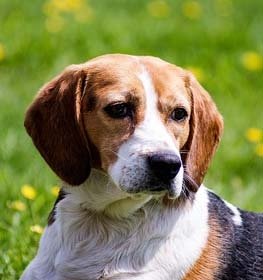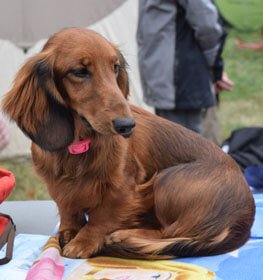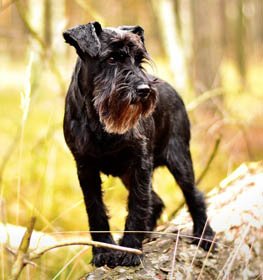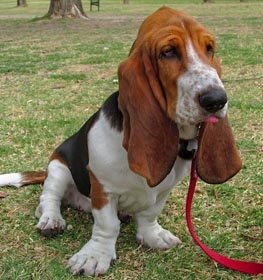Dandie Dinmont Terrier Information & Dog Breed Facts
Collection of all the general dog breed info about Dandie Dinmont Terrier so you can get to know the breed more.
| Group | Hunting Dogs |
|---|---|
| Popularity Rank | 182 |
| Reviews | 1 |
| User Ratings | |
|
Compare the Dandie Dinmont Terrier With Other Dogs
Select at least one dog breed to make the comparsion. | |
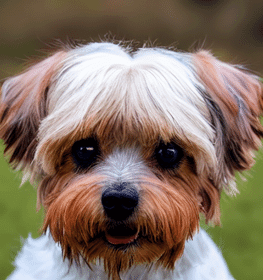 | |
| Origin | |
|
Common Names & Aliases
What other names is a Dandie Dinmont Terrier known by? Discover all traditional, regional and informal names used for this breed. | Hindlee TerrierDandie |
|---|---|
|
Breed Classification
What type of dog breed is a Dandie Dinmont Terrier? Learn about its genetic classification and breeding category. | Purebred |
|
Size Classification
What size category is a Dandie Dinmont Terrier? Learn how big the Dandie Dinmont Terrier breed typically grows. | Small |
|---|---|
|
Weight Statistics
How much does a Dandie Dinmont Terrier weigh? Discover typical weight ranges for adult males and females of the Dandie Dinmont Terrier breed. | 18-24 pounds (8-11 kg) |
|
Average Weight
What is the average weight of a Dandie Dinmont Terrier? | 21 pounds (9.5 kg) |
|
Height
How tall is the Dandie Dinmont Terrier? Dandie Dinmont Terrier height: | 8-11 inches (20-28 cm) |
|
Average Height
What is the average height of a Dandie Dinmont Terrier? | 9.5 inches (24 cm) |
|
Price Range
How much does a Dandie Dinmont Terrier puppy cost? Find current market prices and factors affecting Dandie Dinmont Terrier costs. | $1400-$1600 If you choose to purchase the Dandie Dinmont Terrier, you should know that the mentioned amount of money is an average of the collected data from breeders’ sites and puppy finder places. If you have a Dandie Dinmont Terrier for sale, please advertise it on a reliable website to make sure the Dandie Dinmont Terrier gets to a happy place. |
|---|---|
|
Availability
How easy is it to get a Dandie Dinmont Terrier? How many Dandie Dinmont Terrier are there in the world? | Frequent: The Dandie Dinmont Terrier is easier than average to get. Maybe there is some risk of overbreeding, as it is a popular breed. Due to its popularity, inbreeding may occur. A new study shows that inbreeding contributes to the incidence of disease and health problems. So be careful and seek the help of an experienced person or a professional, in making your decision. |
|
Intelligence Rating
How intelligent is a Dandie Dinmont Terrier? Discover the Dandie Dinmont Terrier's intelligence ranking and learning capabilities. | Low to average: This canine intelligence is not the brightest one. Keep in mind that if you want to teach them any tricks, they understand and memorize new commands in 40-80 repetitions. Dandie Dinmont Terrier obey the first command 30% of the time or better. So if you want to have a smart dog, you might have to reconsider your choice with this breed.
The Dandie Dinmont Terrier ranks below average in the intelligence ranking of dogs. |
|---|---|
|
Training Difficulty
How easy is it to train a Dandie Dinmont Terrier? Learn about the Dandie Dinmont Terrier's trainability and response to training methods. | Dandie Dinmont Terrier dogs are quite easy to train. Sometimes they can be challenging, but if you're consistent in teaching new commands they will obey for sure. |
|
Watchdog Rating
How good is a Dandie Dinmont Terrier as a watchdog? Learn about the Dandie Dinmont Terrier's alertness and guarding instincts. | Dandie Dinmont Terrier dogs are average watchdogs. If they sense something different, they will alert you, but observation isn't considered their main job.
|
|
Territorial Protection
Is a Dandie Dinmont Terrier protective of its territory? Learn about the Dandie Dinmont Terrier's guarding instincts and behavior. | Dandie Dinmont Terrier dogs strongly protect their territory. This breed is a complete security guard, so you don't have to be afraid in case of danger. |
|
Personality Traits
What personality does a Dandie Dinmont Terrier have? Learn about characteristic Dandie Dinmont Terrier temperament and behavior traits. | FunnyLovingIndependentIntelligentAffectionateLivelyCompanionableDetermined |
|---|---|
|
Sensitivity Level
How sensitive are they? Dandie Dinmont Terrier sensitivity: | Dandie Dinmont Terrier dogs have an average emotional level and are not the most sensitive dog breed. Sometimes it's okay to change the daily routine, have guests and listen to loud music.
Some dogs handle moderate punishment very well, while others crumble apart at a dirty look. This breed is not affected emotionally by moderate punishment. |
|
Affection Level
How affectionate are they? Is a Dandie Dinmont Terrier a good family dog? | Average: Dandie Dinmont Terrier dogs are average dogs regarding their affection level. Some breeds are forthcoming and friendly, while others are independent and don't bond too closely with their owners. |
|
Social Needs
How much social interaction does the Hindlee Terrier need? Dandie Dinmont Terrier social needs: | Dandie Dinmont Terrier dogs need for social interaction is average. This breed likes being around people or other animals, but they don't mind being left alone for a few hours either. |
|
Impulse to Wander or Roam
How likely is the Dandie Dinmont Terrier to run away? Does this breed explore or wander a lot? Does Dandie Dinmont Terrier roam? | Dandie Dinmont Terrier dogs have average wanderlust potential. Sometimes they like to explore the world and they might escape once or twice, but usually, they prefer staying safely at home. Safer to teach them how to get back to you on command. |
|
Prey Drive
Do this canine have a strong prey drive? Does Dandie Dinmont Terrier have high prey drive? | Dandie Dinmont Terrier dogs have a higher impulse to chase and catch something than other dog breeds. Cats or any other small animals might be in danger. It's a natural instinct, doesn't necessarily mean that Dandie Dinmont Terrier dogs are aggressive. Better to keep this breed on a leash. |
|
Barking Frequency
Does a Dandie Dinmont Terrier bark a lot? Learn about typical Dandie Dinmont Terrier vocalization patterns and triggers. | Low to Average: The Dandie Dinmont Terrier rarely barks. This breed could be a good choice if you're looking for a quiet breed. They don't bark unless there is a good reason.
Top reasons for barking: protection, alarm, fear, boredom, attention-seeking, greeting, separation anxiety, compulsive barking. |
|---|---|
|
Playful Nature
How playful is a Dandie Dinmont Terrier? Understand the typical play drive and energy level of the Dandie Dinmont Terrier breed. | Average: Dandie Dinmont Terriers, like any other dog breed, like playing. Sometimes they bark in excitement for playing, but they are not the most playful dog breed. |
|
Apartment Adaptability
Can a Dandie Dinmont Terrier live in an apartment? Learn about the Dandie Dinmont Terrier's suitability for apartment living. | Very house-friendly dog the Dandie Dinmont Terrier breed. It's good if you have a small garden where he can go out and do his business, but it's not important at all. You can get enough exercise with one or two walks a day, so keeping them indoors shouldn't be a problem. |
|
Lifestyle Adaptability
How adaptable is a Dandie Dinmont Terrier to lifestyle changes? Learn about the Dandie Dinmont Terrier's flexibility to new situations. | Dandie Dinmont Terrier dogs adapt very well to lifestyle changes and basically all living environments. They don't mind moving from one place to another with their owner. |
|---|---|
|
Alone Time Tolerance
Can a Dandie Dinmont Terrier be left alone? Learn about the Dandie Dinmont Terrier's tolerance to solitude. | Just like every puppy, they are prone to panic, cry, bark, whine when they left alone by their owner. With proper socialization and quality time with the dog can solve this problem. |
|
Bite Risk Assessment
What is a Dandie Dinmont Terrier biting potential? Learn about the Dandie Dinmont Terrier's bite risk factors. | Low 🔽 The Dandie Dinmont Terrier has a low chance of biting somebody. Top reasons for dog bite: protection, pain, excitement, herding instinct, being provoked. (Data based on the available online bite statistics.) |
|---|---|
|
Mouthing Tendency
Is a Dandie Dinmont Terrier mouthy? Learn about the Dandie Dinmont Terrier's tendency to use mouth during play. | Dandie Dinmont Terrier dogs have an average tendency to nip, chew, playbite, or herd people. It's a common habit during puppyhood, not aggressive behavior. These "bites" don't hurt, but Dandie Dinmont Terrier dogs need to be taught a good attitude. |
|
Bite Strength Rating
How strong is a Dandie Dinmont Terrier bite? Learn about the Dandie Dinmont Terrier's bite force measured in PSI. | Between 100 and 200 PSI 🔽 Dandie Dinmont Terrier bite force: Weak. The Dandie Dinmont Terrier bite force is considered weak when compared to other dog breeds. The bite force Dandie Dinmont Terrier measurements usually fall below 200 PSI, making them one of the breeds with the weakest bite force. The bite force of a Dandie Dinmont Terrier may be weak, but it's important to remember that any dog's bite can still be dangerous if not managed properly. Despite the bite force of Dandie Dinmont Terrier being lower, it does not make them any less lovable or enjoyable as pets.
Dandie Dinmont Terrier bite wounds might not be as severe, but it is still essential to be cautious and prevent any biting incidents. They are usually not aggressive and very friendly towards children and other animals. To ensure a well-behaved dog, it's essential to learn how to train a Dandie Dinmont Terrier puppy not to bite from an early age. With proper training and socialization, a Dandie Dinmont Terrier can be a wonderful addition to any family, providing love and companionship for years to come. |
|
Average Lifespan
How long does a Dandie Dinmont Terrier live? Learn about the typical lifespan of the Dandie Dinmont Terrier breed. | 12-14 years The average lifespan of Dandie Dinmont Terrier: 13 years |
|---|---|
|
Climate Tolerance
How well does a Dandie Dinmont Terrier handle different weather? Learn about the Dandie Dinmont Terrier's climate adaptability. | Tolerates warm and cold weather Dogs that tolerate hot and cold weather are typically those that have a double coat of fur. Dogs with a double coat of fur have a layer of fur that insulates their skin and helps protect them from the cold and the heat. |
|
Health Concerns
What health issues are common in a Dandie Dinmont Terrier? Discover typical conditions affecting the Dandie Dinmont Terrier breed. | Dandie Dinmont Terriers tend to have more frequent health issues than other breeds. Regular vet check-ups are needed.
|
|
Vet Care Frequency
How often does a Dandie Dinmont Terrier need vet visits? Learn about the Dandie Dinmont Terrier's veterinary care requirements. | Frequent The Dandie Dinmont Terrier should have a complete physical check-up at least once (but preferably twice) per year. If your dog shows any symptoms, call your veterinarian. |
|
Energy Rating
How energetic is a Dandie Dinmont Terrier? Understand daily activity needs of the Dandie Dinmont Terrier breed. | Dandie Dinmont Terrier dogs have an average energy level, so if you live a semi-active life, this breed can be a good choice for you. |
|---|---|
|
Activity Requirement / Exercise Need
How much exercise does a Dandie Dinmont Terrier need? How much exercise do Dandie Dinmont Terrier dogs require per day?
Do Dandie Dinmont Terrier dogs need a lot of exercises? | Dandie Dinmont Terrier dogs have an average exercise need. This breed is satisfied with short walks every weekday and a long ones on weekends. |
|
Sleeping Need
How much sleep does the Dandie Dinmont Terrier breed need? | Dandie Dinmont Terrier dogs sleep 12-14 hours a day as an average dog and they're not considered a lazy breed. |
|
Obesity Tendency
Is a Dandie Dinmont Terrier prone to weight gain? Learn about the Dandie Dinmont Terrier's obesity risks. | Average to High: If you don't pay attention to the Dandie Dinmont Terrier's weight, he can easily gain weight. More than one daily walk should be on schedule. To make your dog happy and fit, feed him with quality dry dog food and live an active life together. Try to find the happy medium between exercise and feeding.
If you notice any weight gain, consult your veterinarian and make a diet plan. Reduce unhealthy food and snacks, and measure the Dandie Dinmont Terrier weight regularly. |
|---|---|
|
Food Consumption
How much food does a Dandie Dinmont Terrier need daily? Learn about the Dandie Dinmont Terrier's feeding requirements. | 1 to 1.5 cups of high-quality dry food a day, divided into two meals. |
|
Allergy Friendliness
Is a Dandie Dinmont Terrier hypoallergenic? Learn about the Dandie Dinmont Terrier's suitability for allergy sufferers. | Yes Dandie Dinmont Terrier dogs do well with allergy sufferers by causing fewer allergic reaction. However there are no 100% hypoallergenic dogs in the world, there are a variety of breeds that are considered to reduce or minimize the possibility of an allergic response. Coat type isn't necessarily relevant, because most people are allergic to dander (flakes on the dog's skin) or saliva, not actually to dog hair. |
|---|---|
|
Coat Colors
What colors does a Dandie Dinmont Terrier come in? Discover all possible Dandie Dinmont Terrier color variations. | Gray White SilverYellow |
|
Grooming Requirements
How much grooming does a Dandie Dinmont Terrier need? Learn about Dandie Dinmont Terrier coat maintenance requirements. | Average: The Dandie Dinmont Terrier requires average grooming effort. Cutting the dog's hair by a professional groomer isn't essential. Brushing the dog's coat is useful to reduce shedding. Ears and eyes should be cleaned regularly to avoid infections. Don't skip the seasonal flea treatment too. Dog nail trimming and dog bath can be helpful sometimes. Check the local pet store for dog grooming supplies and find the best dog shampoo to keep its coat healthy and give your dog a pleasant experience of a dog bath. If you don't have the time, skill, or money to take care of your Dandie Dinmont Terrier, search for a dog groomer or clipping service in your area and book an appointment. Maybe you're lucky to have a dog boarding service that includes grooming or walk-in dog bath places nearby. |
|
Drooling Tendency
Does a Dandie Dinmont Terrier drool a lot? Learn about the Dandie Dinmont Terrier's drooling habits. | The Dandie Dinmont Terrier is a perfect example of a very low drooling tendency. If you're disgusted by slobber spots on your clothes, the Dandie Dinmont Terrier could be a perfect choice for you. Drooling is the unintentional saliva flowing outside of the mouth. It can be completely normal or a sign of a health problem. Certain dog breeds drool minimum compared to others, just like the Dandie Dinmont Terrier.
If you notice any change in your dog's drooling habit, you should contact a vet as soon as possible. |
|
Stinkiness Rating
Does a Dandie Dinmont Terrier smell bad? Learn about the Dandie Dinmont Terrier's natural odor levels. | Medium ⏺ The Dandie Dinmont Terrier has an average chance of bad smell. Top reasons for dog stinkiness: infection of bad tooth/ear/skin folds, gas attacks. |
|
Coat Characteristics
What type of coat does a Dandie Dinmont Terrier have? Learn about the Dandie Dinmont Terrier's fur characteristics. | SoftHard |
|
Bathing Needs
How often does a Dandie Dinmont Terrier need baths? Learn about the Dandie Dinmont Terrier's bathing requirements. | 3-4 weeks More often than average. These dog coats tend to be longer, softer, and oilier than short-haired breeds. While a good bath every now and then is a great way to keep your buddy from becoming overly smelly, be mindful about overbathing.
Bathing will wash away your dog’s natural oils, while a simple brushing every few days should keep them clean. |
|
Shedding Level
How much do Dandie Dinmont Terrier dogs shed? How to control, reduce and prevent the shedding of the Hindlee Terrier? Do Dandie Dinmont Terrier dogs shed a lot? | Dandie Dinmont Terrier dogs shed none to minimal. Having a puppy from this breed you don't have to be afraid of your couch or car being covered by dog hair. Dandie Dinmont Terrier dogs could be the best choice if you don't tolerate dog hair. |
|
Child Compatibility
Is a Dandie Dinmont Terrier good with children? Learn about the Dandie Dinmont Terrier's behavior around kids of different ages. | Dandie Dinmont Terrier dogs are kid-friendly dogs. This breed is a good choice if you have children. |
|---|---|
|
Pet Compatibility
How well does a Dandie Dinmont Terrier get along with other pets? Discover the Dandie Dinmont Terrier's compatibility with other animals. | Dandie Dinmont Terrier dogs are generally with other pets. |
|
Stranger Friendly
Are they aggressive or friendly towards/with strangers? Dandie Dinmont Terrier temperament with other people: | Dandie Dinmont Terrier dogs are average friendly towards strangers. |
|
Cat Friendly
How well do Dandie Dinmont Terrier dogs get along with cats? Are they good with kittens? What is this fido's temperament with cats? Can they be good with cats? Can the Dandie Dinmont Terrier breed live with a cat? | Dandie Dinmont Terrier dogs are average friendly towards cats. |
|
Dog Friendly
Is Dandie Dinmont Terrier good with other dogs? Are they dog-friendly dogs? How well do Dandie Dinmont Terrier dogs get along with other dogs? | Dandie Dinmont Terrier dogs are dog-friendly dogs. If you want more dogs in your family or you'd like to join dog meetups, the Dandie Dinmont Terrier can be a great choice. |
|
Good For First Time Owners
Is Dandie Dinmont Terrier breed good for first-time owners? Do they make a good dog for novice owners? Is Dandie Dinmont Terrier breed suitable for first-time owners? | Yes Dandie Dinmont Terrier dogs are good for novice owners, due to their easy-going personality. |
|
Office Friendly
Are Dandie Dinmont Terrier dogs good office canines? Do Dandie Dinmont Terrier dogs make good office-friendly pets? Can they be office dogs? | No Dandie Dinmont Terrier is not the best dog breed for office environment. |
|
Senior Citizens Friendly
Are they senior citizens friendly dogs? How well do Dandie Dinmont Terrier dogs get along with the elderly people? What is the Hindlee Terrier temperament with senior people? Are Dandie Dinmont Terrier dogs good for elderly owners? | Dandie Dinmont Terriers are usually recommended for elderly people. |
|
Service Dog Capability
Can a Dandie Dinmont Terrier be a service dog? Learn about the Dandie Dinmont Terrier's service work potential. | Not really This breed generally not used as a service dog. A service dog is a term used in the USA to refer to any type of assistance dog specifically trained to help people who have disabilities, such as visual impairment, hearing impairments, mental disorders, seizures, mobility impairment, and diabetes. Service dogs are protected under the ADA (Americans with Disabilities Act).
Dandie Dinmont Terrier is not the best breed for service purposes. |
|---|---|
|
Therapy Work Suitability
Is a Dandie Dinmont Terrier good as a therapy dog? Learn about the Dandie Dinmont Terrier's therapy work aptitude. | Not really This breed is generally not used as a therapy dog. A therapy dog is a dog that might be trained to provide affection, comfort, and love to people in hospitals, retirement homes, nursing homes, schools, hospices, disaster areas, and people with anxiety disorders or autism.
Dandie Dinmont Terrier is not the best breed for therapeutic purposes. |
|
Scent Detection Ability
Is a Dandie Dinmont Terrier good at detection work? Learn about the Dandie Dinmont Terrier's scenting abilities. | Not really They are not typically employed for this type of work, but there may be exceptional cases. A detection dog or sniffer dog is a dog that is trained to use its senses (mostly its smell) to detect substances such as explosives, illegal drugs, wildlife scat, currency, blood, and contraband electronics such as illicit mobile phones.
Dandie Dinmont Terrier is not the best breed for detection purposes. |
|
Search & Rescue Potential
Can a Dandie Dinmont Terrier do search and rescue? Learn about the Dandie Dinmont Terrier's SAR capabilities. | Not really This dog breed is not typically used as a search and rescue dog. The use of dogs in search and rescue (SAR) is a valuable component in wilderness tracking, natural disasters, mass casualty events, and locating missing people.
The Dandie Dinmont Terrier is not the best breed for SAR purposes. |
|
Maritime Work Ability
Is a Dandie Dinmont Terrier good on boats? Learn about the Dandie Dinmont Terrier's maritime capabilities. | Not really Dandie Dinmont Terrier breed usually doesn't like being on a boat. Boat dogs were typically bred for their strength, stamina, and water resistance, as they were often required to perform tasks such as pulling in fishing nets, and jumping into the water to retrieve ropes or lines, or helping to move cargo. Sailor dog is a type of dog that was bred to accompany sailors on their voyages. They were typically used for three purposes: as a working dog, a watchdog, and as a companion. A boat dog is a term used to describe a type of dog that was traditionally bred and used as a working dog on boats. |
|
Draft Work Capability
Can a Dandie Dinmont Terrier pull carts? Learn about the Dandie Dinmont Terrier's drafting abilities. | Not really A drafting dog or draft dog is a dog bred and used for cart pulling. Dogs bred for this work have strong builds and qualities that are needed, strength and determination.
Dandie Dinmont Terrier is not the best breed for drafting purposes. |
|
Military Service Background
Was a Dandie Dinmont Terrier used in military service? Learn about the Dandie Dinmont Terrier's military history. | Not really In history, this breed was not really used for combat dog. |
|
Puppy Litter Size
How many puppies does a Dandie Dinmont Terrier usually have? Learn about typical litter sizes. | 3-6 puppies |
|---|---|
|
Pregnancy Duration
How long is a Dandie Dinmont Terrier pregnant? Learn about the Dandie Dinmont Terrier's gestation period. | 60-64 days Reproductive cycle of the female Dandie Dinmont Terrier: The first period called Proestrus lasts for about 9 days.
During this time the females start to attract males. You can notice by swelling vulva and bloody discharge. The second part is the Estrus when the female is receptive for the male. It lasts for about 3 to 11 days. The sign of the proestrus part is the soft and enlarged vulva. The discharge decreases and lightens in color. The third part is the Diestrus. Normally, it occurs around day 14. In this period the female’s discharge changes for vivid red and coming to its end. The vulva returns to average, and she will no longer permit mating. The fourth part called the Anestrus. The time frame between heat periods normally lasts about six months. |
|
Breeding Frequency
How often can a Dandie Dinmont Terrier have puppies? Learn about safe breeding intervals. | Once a year. More frequent breeding is not healthy. It is very important not to buy a dog from a puppy mill, where the needs of the pups and their mothers are ignored. It's an inhumane high-volume dog breeding facility, where puppies born several times a year. |
|
AKC Classification
What AKC group is a Dandie Dinmont Terrier in? Learn about the Dandie Dinmont Terrier's AKC classification. | Recognized by the American Kennel Club in 1886 as a Terrier breed. |
|---|---|
|
FCI Classification
What FCI group is a Dandie Dinmont Terrier in? Learn about the Dandie Dinmont Terrier's international classification. | Recognized by FCI in the Terriers group, in the Small sized Terriers section. |
|
Kennel Club Recognition
Which kennel clubs recognize a Dandie Dinmont Terrier? Learn about the Dandie Dinmont Terrier's official recognition. | American Canine RegistryAmerican Kennel ClubAmerica's Pet RegistryCanadian Kennel ClubDog Registry of America Inc.Federation Cynologique InternationaleKennel Club of Great BritainNorth American Purebred Registry, Inc.American Canine Association, Inc.Australian National Kennel CouncilContinental Kennel ClubNational Kennel ClubNew Zealand Kennel ClubUnited Kennel ClubClub Espanol De Terriers |
Dandie Dinmont Terrier Pros and Cons
- Allergy Friendliness: Dandie Dinmont Terrier dogs do well with allergy sufferers by causing fewer allergic reaction.
- Apartment Adaptability: Very house-friendly dog the Dandie Dinmont Terrier breed.
- Shedding Level: Dandie Dinmont Terrier dogs shed none to minimal.
- Drooling Tendency: The Dandie Dinmont Terrier is a perfect example of a very low drooling tendency.
- Lifestyle Adaptability: Dandie Dinmont Terrier dogs adapt very well to lifestyle changes and basically all living environments.
- Child Compatibility: Dandie Dinmont Terrier dogs are kid-friendly dogs.
- Dog Friendly: Dandie Dinmont Terrier dogs are dog-friendly dogs.
- Senior Citizens Friendly: Dandie Dinmont Terriers are usually recommended for elderly people.
- Good For First Time Owners: Dandie Dinmont Terrier dogs are good for novice owners, due to their easy-going personality.
- Intelligence Rating: Low to average: This canine intelligence is not the brightest one.
- Health Concerns: Dandie Dinmont Terriers tend to have more frequent health issues than other breeds.
- Obesity Tendency: Average to High: If you don't pay attention to the Dandie Dinmont Terrier's weight, he can easily gain weight.
- Office Friendly: Dandie Dinmont Terrier is not the best dog breed for office environment.
Dandie Dinmont Terrier History
The Dandie Dinmont Terrier’s origins can be traced back to the early 18th century, to the Cheviot Hills between England and Scotland. However, stories about how the breed was developed are very conflicting. Yet the certain thing is that the breed was believed to be especially good at dispatching four-legged prey, including poachers, badger, rabbit, weasel, otters, and other vermin.
According to some scientists, the Dandie Dinmont Terrier is the result of cross-breeding the Otterhound with some local terrier breeds, from the Border Country between Scotland and England. Other sources state that the Dandie Dinmont Terrie evolved from the rough-coated terriers commonly found on farms. The third story about the breed’s initial development believes that the breed emerged after crossing the Dachshund with some local terrier breeds.
Whichever theory is true, it has proven to be true that the Dandie Dinmont Terrier is the oldest distinct terrier breed, which now exists. Contrary to many other terrier breeds, the Dandie Dinmont Terrier did not change much since it was first developed during the early 1700s. The breed we know today resembles a high extent, to the one which was depicted in Gainsborough's 1770 portrait of Henry, 3rd Duke of Buccleuch, even though a number of other breeds have claimed that the dog presented with the Duke it actually their ancestor.
Despite the fact that the Dandie Dinmont Terrier was already long-established, the breed did not have a name, until Sir Walter Scott mentioned the breed in one of his books, Guy Mannering, which was published in 1814. Before then, all the terrier breeds were commonly called “Terrier”, they did not have any distinguishing or unique name. Sir Walter Scott, being a Dandie Dinmont Terrier owner, basically gave the breed their name. He told a story in his book about a farmer named Dandie Dinmont, who possessed multiple dogs of this breed, thus Sir Walter Scott named the breed, after this farmer. Interestingly, the Dandie Dinmont Terrier was the first terrier ever, to be given a distinctive, unique name.
The Dandie Dinmont Terrier caught the attention of 19th-century royals, like French King, Louis Philippe, who kept a couple of Dandies as part of his royal entourage. Later, in 1875, England’s first Dandie Dinmont Terrier Club was formed, and it is still in operation today, which makes this organization one of the oldest ones in the whole world. As a role of the organization, they wrote up a breed standard, which later helped the breed to get an AKC (American Kennel Club) recognition.
The AKC registered the Dandie Dinmont Terrier in 1886, at the AKC’s very first meeting, making the reed the third oldest member breed of the club. After that, during the late 19th century, the breed became especially well-known and loved in England, even Queen Victoria, being an avid dog lover, owned a couple of Dandies. Later, during the years before the Second World War, there were many famous kennels that bred the Dandie Dinmont Terrier. However, unfortunately, during the war, most of these kennels have disappeared. In some sad cases, the breeders had to put the dogs out, due to the lack of nutrition for them.
After the Second World War, some dedicated fanciers and breeders started working really hard in order to re-establish the Dandie Dinmont Terrier. One of the most famous kennels was Bellmead Kennel, they contributed to the breeding until the 1990s, and produced a specimen named Bellmead Delegate, who was a significant sire that won many shows. Nowadays, the Dandie Dinmont Terrier is one of the rarest and most endangered of all the purebred dog breeds. The Kennel Club in England put the breed on their list of endangered indigenous breeds, for the sad reason that there is the real possibility for the Dandie Dinmont Terrier to become extinct.
Latest Dandie Dinmont Terrier Compares
Dandie Dinmont Terrier Names
How old is my Dandie Dinmont Terrier in human years?
You May Also Like
Rate The Dandie Dinmont Terrier Breed
Dandie Dinmont Terrier Comments, Reviews and Questions
- DT
Jul 20, 2023, 1:46:22 AM:
Your review is absolutely if anything for the most part the exact opposite of what a Dandie is like. I have had 3 in my life and I know what I'm talking about. Just unbelievable the mis information here.

